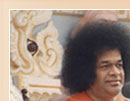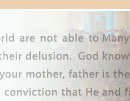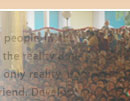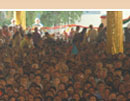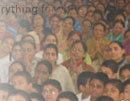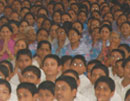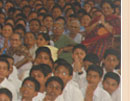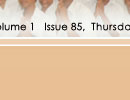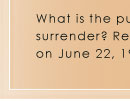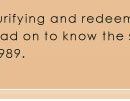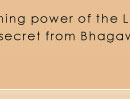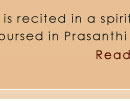Communication is an art that reaches perfection when it is effectively done. Effective communication is impossible without having proper knowledge and understanding of the needs, values and aspirations at the receiving end. But, how does the greatest communicator, Bhagawan, communicate? He does it to perfection effectively bringing transformation. His Life is His Message, He is the Channel, Medium, Language and is also inseparable from His audiences. This phenomenon cannot be explained either by the present or future science of communication, writes Dr. P. R. R. Sinha, formerly Acting Director, Asian Mass Communication Research and Information Centre, Singapore. (from Sanathana Sarathi, March 1979)
The Communicator
During my 25 years of career in the communication profession, I have learnt that the entire communication process can be summed up as "who says what to whom under what conditions and with what effect?" While all the elements are important, the two key elements are `who says' and `to whom'. In other words, the communicator and the communicatee or the sender and the receiver of messages are the most vital elements in the communication process.
In recent years, the importance of communication towards furthering the cause of growth and development is being increasingly realised by all. According to experts, the citadel of development hinges primarily on the socio economic and political facets of the people and the countries and communication plays a significant role in accelerating the pace of growth and development. However, its importance in the field of moral and spiritual developments is still a far cry. This is evident from the lopsided development of the individuals and the societies. Be that as it may, even in fields of socio economic development, the means of communication is not very effective for various reasons.
One of the most important reasons has been the inability of the communicator to communicate well with the audience. This in turn, adversely affects credibility. The communicator also sends messages to the audiences without having proper knowledge and understanding of their needs, values and aspirations. Again, the mechanism of feedback is deplorably inadequate with the result that the communicator is invariably oblivious of the reactions of his audiences to the messages passed on to them. Such is the state of hundreds and thousands of communicators engaged in the profession throughout the world.
Let me try to describe with the help of my little knowledge, the effects and effectiveness of The Greatest Communicator Sri Sathya Sai, the world knows of.
After having come in direct contact with The Communicator in physical form only last December at Brindavan, Bangalore, I was hoping to be at the Holy place Puttaparthi on 7 March on the occasion of the Shivaratri festival. It so happened that on the 23rd February, one of my colleagues advised me to postpone my programme and stay in Singapore because I had recently taken over the new post. I was in a fix, I could not decide what to do. The same evening, I prayed to Sai Baba to advise and lead me to kindly light. And lo and behold! The same night my whole family and myself were with the Bhagawan in my dream. The following morning, I had the message—do not come at this time, come with your family. And this time, I am here with my wife. After a few days of this event, I learnt from a friend of mine who lives in Hyderabad that our Bhagawan would not be at Puttaparthi this year on the Shivaratri Day.
Now, can any science of communication explain this phenomenon of inter personal communication? Is it possible for any communicator to get the message so fast thousands of miles away without any mechanical and electronic devices and respond immediately to the prayers of a devotee? But there is only one Communicator who does this, not only with one person at a time, but with millions of persons at the same time.
The acid test for the success of communication is in its impact on the receivers or audiences. The effectiveness of communication is crucial to its continued efforts towards changing the behaviour complex of the people. Here again, I would, with due apology, describe my personal experience. When I was blessed by my Guru and God on the 21st December, 1977 at Brindavan, He told me not to worry too much, everything will be all right and His Blessings are always with me. Believe me, this single message has completely transformed my entire ethos and philosophy of life. I have read that thousands of devotees have undergone similar transformations in their lives after receiving the blessings from Bhagawan. Can there be a better example of perfect effectiveness of communication? Is it humanly possible to achieve so many results (by way of changing the behaviour of the people) in one act or many acts of communication? Certainly not.
We all know that there must be a message for the communicator to communicate with audiences. Quite a few persons have proclaimed rather vociferously that their lives are their messages. But have they stood the test of time? How often they have failed miserably in proving that their lives are their messages? Our Bhagawan also says "My Life is My Message.” Has there been any gap between what He says and what He does? The way He meets and treats people, the way He cares for them, the way He consoles and clears the doubts, the way He speaks and behaves, all make an indelible imprint on our head and heart and motivate us to act according to messages received.
His messages know no physical barriers and transcend all cultures, all religions, all faiths and all beliefs throughout the universe. Be it Buddhist, Christian, Hindu, Muslim, Parsi, Sikh, all without exception, take to the messages of the Bhagawan as if they emanate from their own Gurus or from The Communicator who is the God of all Gods and Goddesses. His message of the Seven principles of Sathya, Dharma, Santhi, Prema, Devotion, Duty and Discipline, is so effective that it touches the very heart of mankind. Then there are messages tailored specifically to the needs of the individual human beings. They touch the innermost feelings and emotions of the individuals which have snowballing effects on their behaviour. We know of only One Communicator Whose selection and treatment of messages are so incredibly perfect and effective.
Like message, language is another key element in the communication process. Communication scholars have come up with a number of factors leading to the compatibility of the languages, in the absence of which it is hard to achieve desired results in the thinking and doing of the recipients of messages. There is only One Living Communicator who communicates through the "Language of the Heart.” The myriads of people who have directly or indirectly come in contact with The Communicator would vouchsafe that the best language for total effectiveness in communication is and will be for all times to come, the Language of the Heart. People from all parts of the world have had the fortune of being blessed by the Communicator in private interviews. It is a sight to see their faces completely transformed, lit fully with satisfaction after the experience with the Divinity. How effective is the message when the Lord says to the people all over the world, "My place is in your heart; I want your love.” One has only to physically experience the total impact of this message which is communicated through the language of the heart.
Examples abound in to indicate the manner and speed with which He gets a feel of the needs and aspirations of the people and also feedback of His messages. This again knows no geographical boundaries. He can and does communicate and receive feedback from His devotees from all parts of the world at the same point in time. The Greatest Sender of messages is also the Greatest Receiver of messages. It bates all calculus of communication to find various elements of communication intimately immersed in The Communicator Himself. His Life is the Message, He is the Channel, Medium, Language and is also inseparable from His Audiences. This communication phenomenon cannot be explained either by the present or future science of communication.
|
